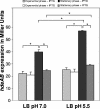Role of the multidrug resistance regulator MarA in global regulation of the hdeAB acid resistance operon in Escherichia coli
- PMID: 18083817
- PMCID: PMC2238188
- DOI: 10.1128/JB.01729-07
Role of the multidrug resistance regulator MarA in global regulation of the hdeAB acid resistance operon in Escherichia coli
Abstract
MarA, a transcriptional regulator in Escherichia coli, affects functions such as multiple-antibiotic resistance (Mar) and virulence. Usually an activator, MarA is a repressor of hdeAB and other acid resistance genes. We found that, in wild-type cells grown in LB medium at pH 7.0 or pH 5.5, repression of hdeAB by MarA occurred only in stationary phase and was reduced in the absence of H-NS and GadE, the main regulators of hdeAB. Moreover, repression of hdeAB by MarA was greater in the absence of GadX or Lrp in exponential phase at pH 7.0 and in the absence of GadW or RpoS in stationary phase at pH 5.5. In turn, MarA enhanced repression of hdeAB by H-NS and hindered activation by GadE in stationary phase and also reduced the activity of GadX, GadW, RpoS, and Lrp on hdeAB under some conditions. As a result of its direct and indirect effects, overexpression of MarA prevented most of the induction of hdeAB expression as cells entered stationary phase and made the cells sevenfold more sensitive to acid challenge at pH 2.5. These findings show that repression of hdeAB by MarA depends on pH, growth phase, and other regulators of hdeAB and is associated with reduced resistance to acid conditions.
Figures




Similar articles
-
pH-Dependent modulation of cyclic AMP levels and GadW-dependent repression of RpoS affect synthesis of the GadX regulator and Escherichia coli acid resistance.J Bacteriol. 2003 Dec;185(23):6852-9. doi: 10.1128/JB.185.23.6852-6859.2003. J Bacteriol. 2003. PMID: 14617649 Free PMC article.
-
GadX/GadW-dependent regulation of the Escherichia coli acid fitness island: transcriptional control at the gadY-gadW divergent promoters and identification of four novel 42 bp GadX/GadW-specific binding sites.Mol Microbiol. 2008 Nov;70(4):965-82. doi: 10.1111/j.1365-2958.2008.06458.x. Epub 2008 Sep 18. Mol Microbiol. 2008. PMID: 18808381
-
GadE (YhiE) activates glutamate decarboxylase-dependent acid resistance in Escherichia coli K-12.Mol Microbiol. 2003 Sep;49(5):1309-20. doi: 10.1046/j.1365-2958.2003.03633.x. Mol Microbiol. 2003. PMID: 12940989
-
Leucine-responsive regulatory protein: a global regulator of gene expression in E. coli.Annu Rev Microbiol. 1995;49:747-75. doi: 10.1146/annurev.mi.49.100195.003531. Annu Rev Microbiol. 1995. PMID: 8561478 Review.
-
The Escherichia coli multiple antibiotic resistance activator protein represses transcription of the lac operon.Biochem Soc Trans. 2019 Apr 30;47(2):671-677. doi: 10.1042/BST20180498. Epub 2019 Mar 8. Biochem Soc Trans. 2019. PMID: 30850424 Review.
Cited by
-
Genetic inactivation of acrAB or inhibition of efflux induces expression of ramA.J Antimicrob Chemother. 2013 Jul;68(7):1551-7. doi: 10.1093/jac/dkt069. Epub 2013 Mar 14. J Antimicrob Chemother. 2013. PMID: 23493314 Free PMC article.
-
Regulation of acrAB expression by cellular metabolites in Escherichia coli.J Antimicrob Chemother. 2014 Feb;69(2):390-9. doi: 10.1093/jac/dkt352. Epub 2013 Sep 15. J Antimicrob Chemother. 2014. PMID: 24043404 Free PMC article.
-
Extreme Acid Modulates Fitness Trade-Offs of Multidrug Efflux Pumps MdtEF-TolC and AcrAB-TolC in Escherichia coli K-12.Appl Environ Microbiol. 2021 Jul 27;87(16):e0072421. doi: 10.1128/AEM.00724-21. Epub 2021 Jul 27. Appl Environ Microbiol. 2021. PMID: 34085861 Free PMC article.
-
The RyfA small RNA regulates oxidative and osmotic stress responses and virulence in uropathogenic Escherichia coli.PLoS Pathog. 2021 May 27;17(5):e1009617. doi: 10.1371/journal.ppat.1009617. eCollection 2021 May. PLoS Pathog. 2021. PMID: 34043736 Free PMC article.
-
The Multidrug Efflux Regulator AcrR of Escherichia coli Responds to Exogenous and Endogenous Ligands To Regulate Efflux and Detoxification.mSphere. 2022 Dec 21;7(6):e0047422. doi: 10.1128/msphere.00474-22. Epub 2022 Nov 23. mSphere. 2022. PMID: 36416552 Free PMC article.
References
-
- Alekshun, M. N., and S. B. Levy. 1999. The mar regulon: multiple resistance to antibiotics and other toxic chemicals. Trends Microbiol. 7410-413. - PubMed
-
- Arnqvist, A., A. Olsen, and S. Normark. 1994. Sigma S-dependent growth-phase induction of the csgBA promoter in Escherichia coli can be achieved in vivo by sigma 70 in the absence of the nucleoid-associated protein H-NS. Mol. Microbiol. 131021-1032. - PubMed
-
- Barbosa, T. M., and P. J. Pomposiello. 2005. The mar regulon, p. 209-223. In D. G. White, M. N. Alekshun, and P. F. McDermott (ed.), Frontiers in antimicrobial resistance: a tribute to Stuart B. Levy. ASM Press, Washington, DC.
Publication types
MeSH terms
Substances
Grants and funding
LinkOut - more resources
Full Text Sources
Molecular Biology Databases
Research Materials
Miscellaneous

